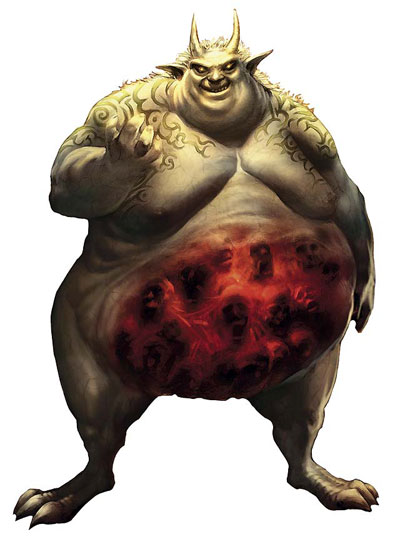DISCUSSING
In the Shadow of the Spire – Chaos Lorebook: The Bloated Lords
Some among the zaug were transformed by the Galchutt and “turned to a new purpose”. As the zaug were made living receptacles for manifest corruption, the zaug soulharvesters became living prisoners for captured and tormented souls.
“Their very flesh burned with the fire of the souls which screamed within them.”
“Their hunger was without end, fed eternally by the torment of those who seared their flesh.”
This week’s campaign journal is The Bloated Lords, a lengthy chaos lorebook describing the zaug, one of the Servitors of the Galchutt.
In the Ptolus campaign setting, the Galchutt are lords of chaos and the Servitors of the Galchutt are demon-like creatures who, as their name suggests, serve them. Along with the strange arts of chaositech which are inimically tied to these entities, you can point to a goulash of antecedents Monte Cook is drawing from — Lovecraft, Moorcock, Warhammer, cenobites, etc. — but the result, particularly when blended into traditional D&D fantasy, is very distinct.
When I brought Ptolus into my own campaign world, however, the Galchutt posed a conundrum: I already had my own pantheon of Mythos-adjacent strange gods.
I thought about replacing the Galchutt with my own pantheon, but then I’d lose a lot of cool stuff. It would be a bunch of extra work for, at best, a neutral result.
Another option would have been to simply add the Galchutt to my pantheon: The more strange gods the merrier! For various reasons, though, they didn’t really sync. I’m a big fan of adaptation and reincorporation, but it’s not always a boon. Sometimes you shove stuff together and you’re left with less than what you started.
So what I eventually ended up doing was nestling the Galchutt into a lower echelon, as “Dukes” in the Demon Court. They brought with them the Dukes (powerful, demon-like entities) and the Elder Brood (demonic monsters who serve the Dukes). This worked really well, creating an unexpected bridge (Elder Brood → Dukes → Galchutt → Demon Court → even stranger depths of the pantheon) between the inexplicable and the mortal world. It’s a good example of how you can pull in influences from a lot of different places and gestalt them into something cool.
Another example of this was the Elder Brood: In the Chaositech sourcebook, only two examples of the Elder Brood are given (the obaan and the sscree). I knew I wanted more than that, so I hit up one of my favorite monster manuals: The Book of Fiends from Green Ronin. (Which also played a major role in my remix of Descent Into Avernus.) I pulled all the cool devils and demons from that book that had the right flavor for the Elder Brood and added them to the roster.
Along similar lines, the zaug — one of the Servitors and described in The Bloated Lords lorebook — were expanded in my campaign to include the Soulharvesters. These were adapted from solamiths, a monster described in Monster Manual V.
If I recall correctly, the specific sequence here was:
- I was looking for a miniature I could use for the zaug (since I knew that one would appear in the Mrathrach Machine).
- I found the solamith miniature and realized it belonged to a monster from Monster Manual V.
- I checked out the solamith write-up and realized thar it could be folded into the mythology of the zaug.
It’s been a while, though, so my sequencing on this may not be correct. (I may have found the solamith write-up first while scavenging monsters for the campaign and then tracked down the miniature from there.) In any case, it’s a technique I’ve used with monster manuals for a long time. It’s similar to The Campaign Stitch, but rather than melding adventures it takes monsters and asks: What if these are the same monster?
It’s kind of like palette shifting, but rather than taking one stat block and using it to model a multitude of creatures, this technique — let’s call it monster melding — takes a bunch of different stat blocks and brings them together.
Another example is that, in my personal campaign world, goblins, orcs, hobgoblins, and ogres are all the same species. (Which, conveniently, gives me access to a much larger variety of stat blocks to plug-‘n-play with while stocking goblin villages.)
What I like about this technique — in addition to utilitarian stocking adventages — is that, much like gods and ventures, the melded monsters can often be more interesting than using the two separately. (For example, the implications of hypertrophic dimorphism in goblins raises all kinds of interesting worldbuilding questions and the soulharvesters, in my opinion, make zaug society much more interesting to explore.)
So ask yourself:
- What if these are the same creature with slightly divergent careers, abilities, etc.?
- What if these are the same creature at different stages of its life cycle?
- What if they live in some kind of symbiosis or parasitic relationship?
Bring these creatures together and see what you get!
Campaign Journal: Session 40C – Running the Campaign: Moral Dilemmas of Magic
In the Shadow of the Spire: Index













